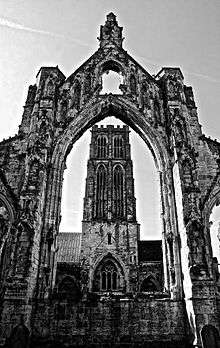Howden Minster
| Howden Minster | |
|---|---|
 Howden Minster, East Riding of Yorkshire | |
| 53°44′43″N 0°52′02″W / 53.745300°N 0.867200°WCoordinates: 53°44′43″N 0°52′02″W / 53.745300°N 0.867200°W | |
| Denomination | Church of England |
| Churchmanship | Anglo-Catholic |
| Website | |
| History | |
| Dedication | St Peter and St Paul |
| Administration | |
| Parish | Howden Minster |
| Deanery | Howden |
| Archdeaconry | East Riding |
| Diocese | York |
| Province | York |
| Clergy | |
| Rector | Rev James Little |
| Vicar(s) | Rev Graham Thornalley |
| Laity | |
| Organist/Director of music | Matthew Collins |
Howden Minster is a large Grade I listed Church of England church in the Diocese of York. It is located in Howden, East Riding of Yorkshire, England. It is one of the largest and most magnificent churches in the East Riding of Yorkshire. It is dedicated to St Peter and St Paul and it is therefore properly known as 'the Minster Church of St Peter and St Paul'. Its Grade I listed status also includes the Chapter House.
History
Howden Minster was owned by monks from Peterborough Abbey in Saxon times, but in 1080 it was gifted to William of Calais (Bishop of Durham). Although dependent on Durham, the minster was in the Diocese of York. Rebuilding the Norman church in the Early English style seems to have been begun in 1228. It became a Collegiate Church in 1267. Rebuilding work was completed in the Decorated style around 1340. A small octagonal Chapter House was built after 1388, the last of its kind to be built in England. The church survived the Dissolution of the Monasteries as it was not a monastery, but fell victim to the Dissolution of Collegiate Churches and Chantries in 1548.
Although the minster was not destroyed in the Dissolution, the choir or chancel was allowed to fall into ruin, and only the nave was used for services. The roof eventually collapsed in 1696, and the chapter house roof collapsed in 1750. The ruins are now in the guardianship of English Heritage, preserved by the Department of the Environment, and are in the condition of a 'safe ruin'. The chapter house received a new roof in 1984. The ruins can only be seen from the outside, as they are still part of the current minster church.

St John of Howden
John was one of the earliest Canons of Howden, who was treated as a saint by the local community after his death, although he has not been officially canonised. Pilgrims, including Kings Edward I, Edward II and Henry V visited the Minster to see his tomb. He had a reputation as a poet in Norman French and Latin writing on religious and lyrical subjects, and had been clerk or confessor to Queen Eleanor of Provence, the wife of King Henry III.[1] He was responsible for the rebuilding of the choir of the minster. He died in 1275 and was buried in a shrine in the choir. The tomb survived until the 16th century. His feast day is 2 May.[2]
See also
References
- ↑ Peach, Howard (2001). Curious Tales of Old East Yorkshire. Sigma Leisure. p. 182. ISBN 1850587493.
- ↑ Little, James. "A Brief history of the Minster An Introduction to Howden Minster:". The Church of England. Retrieved 13 March 2015.
- Keeton, Revd. Canon Barry (2000) Howden Minster, A Guide Book.
External links
| Wikimedia Commons has media related to Howden Minster. |
- History and Research Howden Minster: English Heritage
- Historic England. "Details from image database (165326)". Images of England.